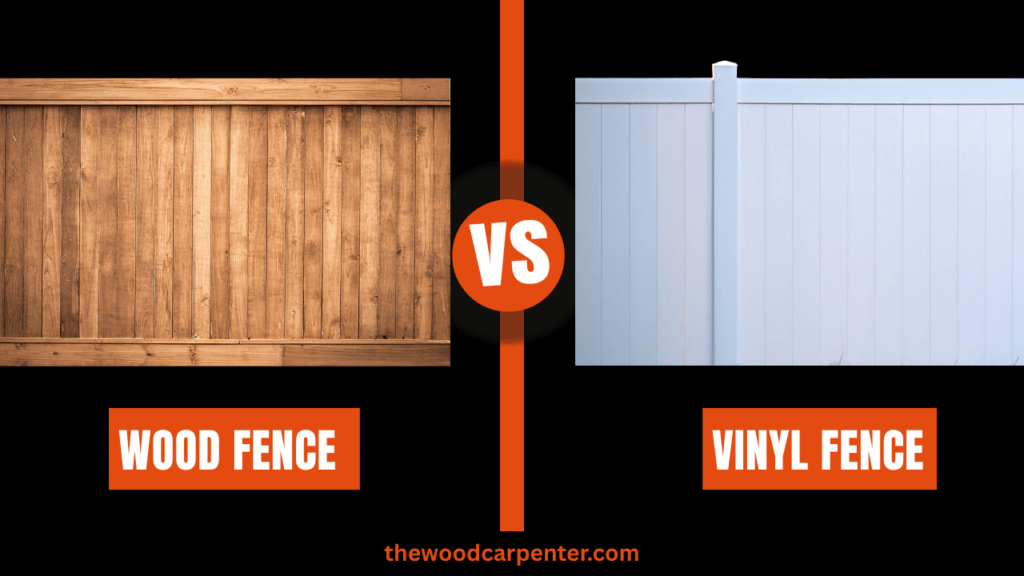
Choosing the right fence for your property means thinking about factors like cost, looks, strength, environmental impact, and how much work it takes to maintain. Two of the most popular types of fences are wood and vinyl, and both have their own pros and cons.
In this article, we will compare wood and vinyl fences to help you decide which is best for you. We’ll look at things like how they look, how much they cost, how easy they are to take care of, and their impact on the environment.
Appearance & Style
Wood Fences
Natural Look: Wood has a classic, warm look that fits well with nature. It’s easy to match with different styles, from traditional picket fences to modern horizontal designs.
Flexibility: Wood can be painted, stained, or left to change naturally. This allows you to update the look of your fence whenever you want, based on changing styles or personal taste.
Variety: You can choose from affordable pine to high-end redwood and cedar, each offering different looks and lifespans.
Vinyl Fences
Consistent Look: Vinyl fences always look neat, with smooth lines and a clean finish. They come in many colors and styles, like white pickets or privacy panels, and they don’t fade or wear out easily.
Modern Look: Some people like the sleek, modern look of vinyl, but others might think it looks too fake compared to real wood.
Durability and Lifespan
| Material | Average Lifespan | Weather Resistance | Insect/Pest Resistance | Typical Issues |
| Wood | 10–20 years | Can warp, crack, rot | Prone to termites, especially untreated wood | Splitting, rot, warping, pest infestation |
| Vinyl | 20–30+ years | Unfazed by moisture, sun, or pests | Not susceptible to insects | Impact damage is possible, panels can crack (often requiring full panel replacement) |
Wood: Wood is naturally strong but can be damaged by decay, weather, and insects if not properly maintained. It needs regular treatment to stay in good condition.
Vinyl: Vinyl, when installed correctly, is resistant to rot and won’t warp, crack, splinter, or attract insects. It can handle bad weather, but it might crack if hit hard or in very cold temperatures.
Repairs: For wood fences, you can replace individual boards when they get damaged. For vinyl, if a panel gets damaged, you usually have to replace the entire panel.
Maintenance
Wood Fences
Regular Upkeep Required: Wood fences need regular care, such as sealing, staining, or painting, to keep them looking good and lasting longer. You should also check for signs of rot or insect damage.
Easy Repairs: If a board or post gets damaged, you can easily replace just that part.
Aging: Without regular maintenance, wood fences can lose their appearance and durability faster.
Vinyl Fences
Low Maintenance: Vinyl fences are often advertised as maintenance-free, but they do need occasional cleaning to remove dirt, mildew, or algae, especially in damp or shaded areas.
Panel Repairs: If vinyl gets heavily damaged, you’ll usually have to replace entire sections of the fence.
Cost Considerations
| Fence Type | Initial Cost | Long-Term Cost | Installation |
| Wood | Lower upfront ($1–$5/ft for pine; more for cedar/redwood) | Can be high due to ongoing maintenance and eventual replacement | DIY-friendly; professional install costs extra |
| Vinyl | Higher upfront (sometimes $2x wood) | Lower over decades; minimal maintenance outlays | Often modular and quick to install; pro labor adds cost but often less than wood in large projects |
Wood: Cheaper to start but can require costly maintenance and sooner replacement in harsh climates.
Vinyl: More expensive at purchase, but its durability and limited maintenance can make it the more economical choice over 20–30 years.
Also read:
Roof Maxx: Miracle Spray or Money Trap ?
Herringbone Flooring: Why Everyone’s Choosing It
Eco-Friendliness
Wood: Wood comes from trees that can grow back if we cut them carefully. It breaks down naturally, so old wood fences can be reused or turned into compost. But some wood is treated with chemicals or painted with certain paints that can hurt the environment.
Vinyl: Vinyl is made from a kind of plastic called PVC, which does not break down naturally and uses a lot of energy to make. Some companies use recycled plastic to make vinyl fences, but these fences still add to plastic waste over time. Right now, most old vinyl fences end up in landfills, though recycling might get better in the future.
Customization & Design Options
Wood: Wood can be easily cut, shaped, and installed to meet any design need. It works well for uneven terrain or custom heights, offering great flexibility in design.
Vinyl: Vinyl comes in many pre-made styles and heights. Once installed, it cannot be easily adapted or repainted, so the look you choose is permanent.
Sustainability and Environmental Impact
Wood: Wood is a natural, biodegradable material, especially when sourced from well-managed forests and left untreated.
Vinyl: While vinyl lasts longer, its plastic construction requires significant resources to produce and is not easily recyclable. If you’re looking for something more sustainable, composite fences might be a good option. They are often made from recycled materials and offer a balance between durability and eco-friendliness.
Pros and Cons of Wood Fence & Vinyl Fence
Wood Fence
Pros:
- Natural beauty, blends with landscape
- Wide range of design and customization
- Budget-friendly upfront
- Biodegradable and traditional
Cons:
- High maintenance commitment
- Regular staining or painting required
- Vulnerable to rot, insects, warping
- Shorter lifespan than vinyl (especially untreated woods)
Vinyl Fence
Pros:
- Exceptionally low maintenance
- Won’t rot, splinter, or attract pests
- Long, consistent lifespan
- Many style choices, keeps original color
Cons:
- Higher initial cost
- Impact repairs often require whole panel replacement
- Not biodegradable; long-term waste a concern
Frequently Asked Questions
1. Which fence lasts longer—wood or vinyl?
Vinyl fences usually last longer than wood. A well-installed vinyl fence can last 20–30 years with minimal maintenance, while even the best-maintained wood fences typically last 10–20 years. High-quality woods like cedar or redwood can last longer than pine, especially with great care.
2. What’s cheaper: a wood fence or a vinyl fence?
Wood fences are cheaper upfront, especially if you go for pine or pressure-treated wood. However, over time, the costs of repairs, staining, and replacements can make vinyl, with its higher initial cost, a better investment in the long run.
3. How much maintenance does each type require?
Wood fences need regular checks, cleaning, and frequent painting or staining. Vinyl fences only need occasional cleaning with soap and water. Vinyl doesn’t need painting, sealing, or pest control.
4. Can vinyl fencing be recycled?
Currently, most vinyl fencing isn’t easy to recycle, though improvements in recycling methods may make it easier in the future. Some vinyl fences are made with recycled materials.
5. Is a wood or vinyl fence better for the environment?
Wood is biodegradable and renewable if sourced responsibly. Over its lifespan, wood generally has a smaller environmental impact than vinyl, which is made from petroleum products and often ends up in landfills.
6. Are there climates where one is better than the other?
Vinyl performs well in humid, rainy, and termite-prone areas but can become brittle in very cold temperatures. Wood can withstand most climates if properly cared for, but it decays faster in damp, wet conditions without extra protection.
7. Which is easier to repair?
Wood fences are easy to repair, as individual panels or slats can be replaced or patched, often with DIY skills. Vinyl fences usually require replacing entire panels or sections, even for small damages.
8. What about resale value?
Both wood and vinyl fences can increase property value. Vinyl is popular for its low maintenance and durability, making it appealing to homebuyers. A well-crafted wood fence, especially made from premium wood, can also boost curb appeal.
Final Thoughts
Wood fences offer a natural, warm look and design flexibility, making them ideal for those who enjoy customizing their fence. However, they require regular upkeep and have a shorter lifespan, especially in harsh weather conditions.
Vinyl fences are more expensive at first but are low-maintenance, durable, and weather-resistant, lasting longer. When choosing between wood and vinyl, consider factors like sustainability, budget, style, repair needs, and how much maintenance you’re willing to do.
The best fence for you is the one that fits your lifestyle and property needs—whether it’s the classic charm of wood, the durability and ease of vinyl, or even looking into eco-friendly options like composite fences.

